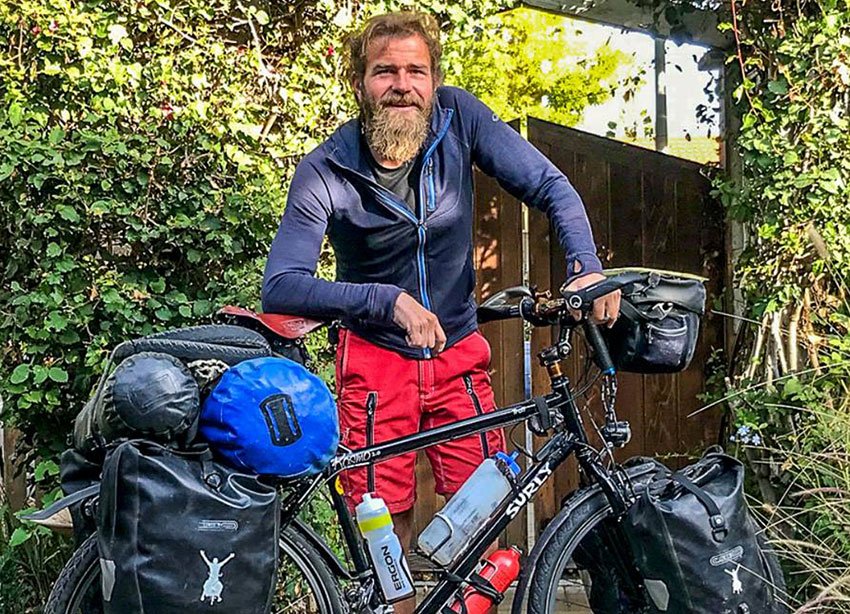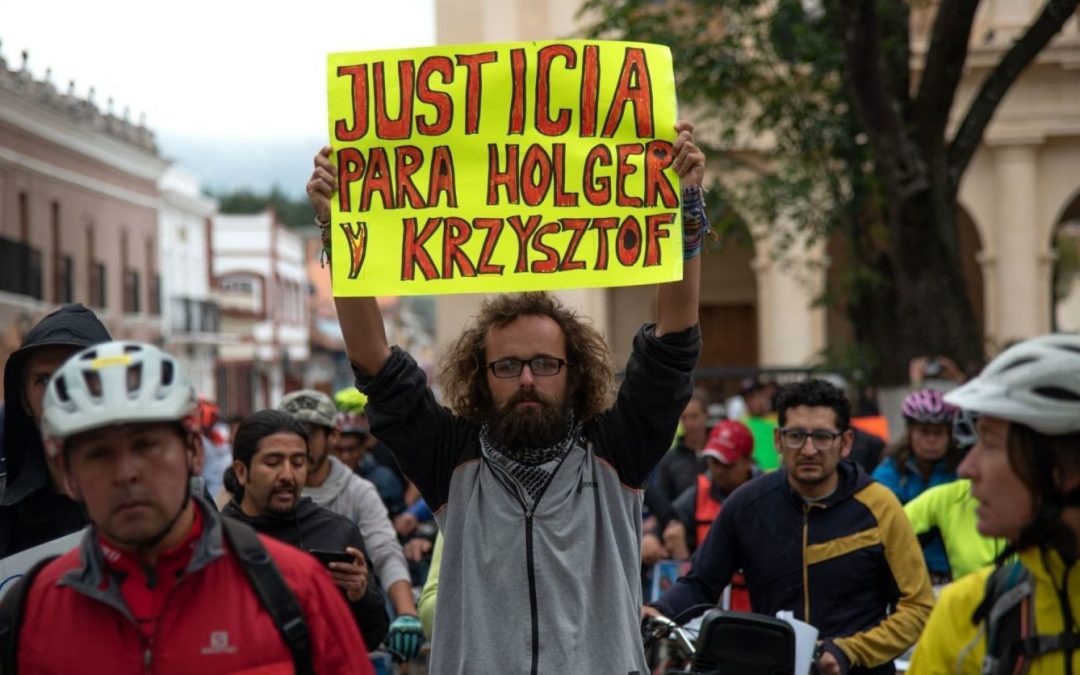In April of 2018, German cyclist Holger Hagenbusch disappeared at the same time as Krzysztof Chmielewski, another cyclist traveling through Mexico on his bike.
Holger Hagenbusch was from Germany and had previously cycled through 34 countries. Krzysztof Chmielewski was from Poland and had previously cycled through 51 countries. Both were very experienced travelers and bikers.
But their experience couldn’t have prepared them for Mexico’s exploding crime rate in recent years.
Disappearance
The two cyclists met in the town of San Cristobal de las Casas on April 20th and decided to travel together to the ancient Mayan ruins at Palenque 200 kilometers (130 miles) away.
Palenque is a tourist destination growing in popularity. Unfortunately, Mexico’s organized crime issues are growing in parallel to tourist visits. In 2017, a year before Holgar disappeared, 28 German tourists were held a gunpoint and robbed after armed thiefs pulled over their bus. This happened in the same approximate region.
The two men were missing for two weeks and last known to be in Chiapas, Mexico.
Discovery Of The Bodies
Chmielewski’s body was found on April 26th and Hagenbusch’s on May 4th. Both bodies were found at the bottom of a ravine in the Mexican state of Chiapas. They were found below a road that runs between Ocosingo and San Cristóbal de las Casas in the country’s far south.
“It’s a very accident-prone area. It’s a very narrow path and the ravine is approximately 200 meters (650 feet) deep. Biking there is actually a very high-risk activity.”
Prosecutor Arturo Lievano
Mexican authorities immediately responded to the discovery of the two bodies, claiming that both must have had a biking accident and falling off of a cliff. They eluded to the curvy roads as the culprit.
The body was in an advanced state of decomposition, and the autopsy found no injuries that suggested murder, though there were multiple fractures, including of the skull.
It wasn’t until a group of fellow cyclists questioned the “accident” conclusion of the Mexican authorities that a newly appointed Mexican prosecutor looked into if the cyclists had been murdered.
“It may have been an assault, because our investigations up to now indicate this was an intentional homicide”
Prosecutor Luis Alberto Sanchez
However, officials pushed back.
The regional attorney general in Chiapas, Arturo Pablo Lievano, said there was no evidence of bad intent and everything pointed to an accident. He said they may have been run off the road by a vehicle.
Brother’s Visit To Mexico

Holger’s brother, Reiner Hagenbusch didn’t believe the official story. There were too many indicators that suggested that foul play was involved. For example, the perpetrators had confused the bikes. Holger’s body was found near Krzysztof’s bike. Krzysztof’s body was found 200 meters away with Holger’s bike.
“Those that did this wanted to make it appear like an accident, so they put the bike there, but they made a mistake and used the German’s bike”
Prosecutor Luis Alberto Sanchez
When Reiner visited the morgue where his brother’s remains were kept, he was shocked. His brother had a gunshot wound on the back of his head. The Polish cyclist was decapitated and had a foot missing.
“The truth is that it was an assassination . . . an assassination that was covered up,”
Reiner Hagenbusch, Holger’s brother
So much for “accident”.
The Aftermath
The killers were never caught, a common result of disappearance and murder cases in Central America.
On 6 May 2018, people from nearby San Cristóbal de las Casa walked with their bikes, to kilometre 158 on the highway where the two men were found. Some protested the Mexican government in search for more answers.
A Trend In Latin America
Getting answers about the disappearance of a loved one in Latin America is a nightmare. Aside from the embarrassment that government officials feel from the spike in publicity from foreign news media, tourism is a precious and well protected industry in Latin America. To protect their tourism industry, politicians often immediately resort to labeling foreigner disappearances as “accidents”, even if the evidence directly proves otherwise.
This is a clear and obvious trend. After a disappearance takes place, authorities immediately use “accident” as their default statement, then they delay investigations in hopes that everyone stops paying attention.
An obvious comparison is the case of Kris Kremers and Lisanne Froon in 2015, in which both girls disappeared on a tourist walking path, only for pieces of their remains to be found three months later. Panama’s officials claimed that it was an accident, regardless of the many unexplainable facts of the case, including that the bones had chemical traces.
Be Careful While Traveling
I’ve written about numerous disappearance stories in Central America. Sometimes their remains are found and sometimes nothing is found. In 90% of cases, they are not found alive.
The dangers present in Latin America are primarily due to opportunists. I’ve written a guide on how to avoid disappearing while traveling through Central America.
My heart goes out to the families of both Holger Hagenbusch and Krzysztof Chmielewski.



The month previous to this incident I was in Tenosique, Tabasco (near Palenque). I had just left Guatemala and was traveling on a motorcyle, heading for a favorite stop a few hours south of San Cristóbal. I’d traveled the longer, more conventional route between Tabasco and Chiapas via the toll highways many times previously (now preferred by tour companies operating between San Cristóbal and Palenque, despite the extra distance, ever since the assault on the tour bus full of Germans), but wanted to try something new, something shorter, more scenic and more fun on a motorcyle. So I did a little research first. Turned out that Highway 199 (the shorter route, paralleling the border with Guatemala), especially the 100 kilometers or so between Ocosingo and San Cristóbal, had a long history of assaults, blockades and other bad press. So it did not score well in my risk assessment and I hesitated.
Turns out, however, that Semana Santa (Easter Week) was around the corner, which means that everyone and their uncle in this part of the world is on vacation. I knew that the authorities would be everywhere along the highways, protecting travelers at this time, and bad guys would be laying low, so I waited. I talked to policemen to confirm this, along with any soldiers I encountered. So I waited until Semana Santa was underway before proving my hypothesis, and a couple days later arrived safe and sound at my destination and with all my body parts.
Two or three weeks later, well after the holidays, hunkered down and happy in Chiapas, news appeared of the discovery of the bodies of the two European cyclists found along that very same stretch. Well, as they say in Spanish, a cautious man is worth two, and this time it was literally true.
Chris is right to mention the overwhelming priority to ‘save face’ among local authorities and avoid bad press. From what I managed to gather, the two cyclists had not been traveling together, but had met in San Cristóbal and decided to team up temporarily on their way to a mutual destination, which was Palenque. Contrary to what was alleged above, that stretch is hardly risky or treacherous at all for most vehicles, including tour buses, much less a bicycle; it’s a broad, well-maintained two-lane secondary highway. The only actual hazards (apart from losing a head or a foot to a maniac with a machete) are the hundreds, possibly thousands, of speed bumps in place, some in blind corners far from any urban areas, put there deliberately to facilitate blockades and assaults by the locals.*
Later, when it was evident that something foul had happened, the authorities tried to link it with drugs, without much if any evidence. They insinuated that these two cyclists were trafficking. My best guess would be that they winked at the wrong girl in some bar in San Cristóbal the night before, pissed off the boyfriend, who later waited for them along a deserted stretch of the highway, not too far from San Cristóbal itself. The killing was a personal vendetta, most likely, IMO.
*It’s rumored that someone actually once counted the speedbumps (‘topes’ in Mexico) and came up with some 2,000 or so along that 100 kilometer stretch. That’s two speed bumps every 100 meters, if you do the math. Probably an exaggerated figure but I was checking my dental fillings at the end of that day nonetheless. So, for the benefit of fellow motorcyclists, this was NOT a fun route on a motorcycle after all.
Also,the locals in this area, mostly indigenous, are not famous for friendliness and are extremely wary of outsiders. The famous uprising in Chiapas, back in the nineties, indeed, had its nucleus in Ocosingo, if I’m not mistaken.